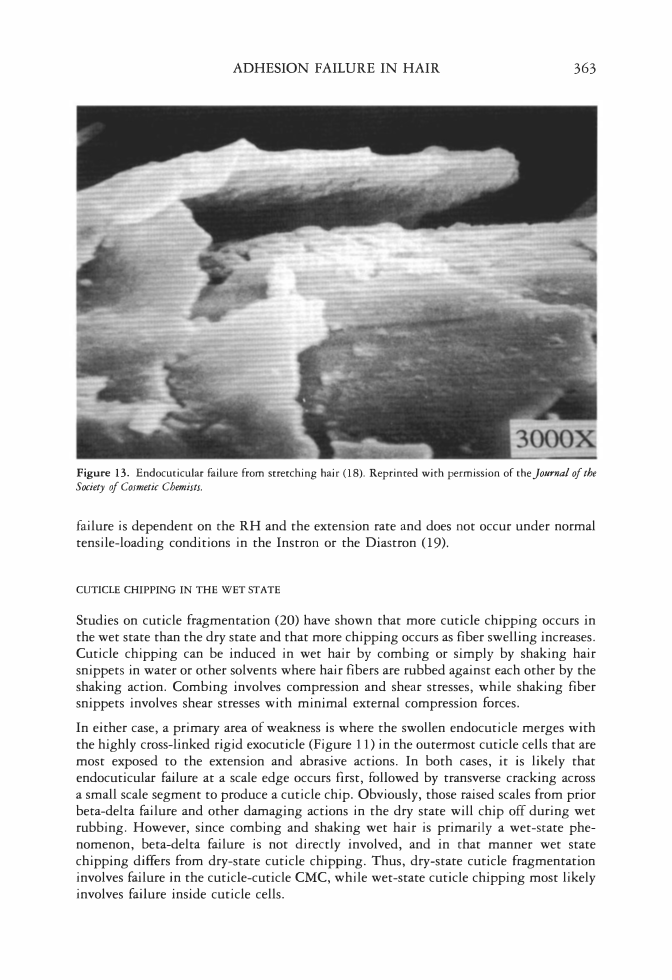362 JOURNAL OF COSMETIC SCIENCE ticular layer, the major area of swelling in the cuticula (Figure 11). Upon wet combing, because of shear forces from abrasion and cyclic extension, sections of cuticle are re moved, leaving large areas of endocuticular debris on the underlying scale surface. This debris confirms endocuticular involvement in this adhesion-failure process (see Fig ure 12). ENDOCUTICULAR FAILURE AT HIGH RH OR IN THE WET STATE This type of failure, leading to scale lifting, has been reported during low-strain-rate extensions by Ruetsch and Weigmann (18) and documented by SEMs (see Figure 13) (12, 18). Endocuticular failure during extension has been attributed to the development of shear stress concentrations, where the highly cross-linked, rigid, exocuticle merges with the low cross-linked, highly swollen, extensible endocuticle (see Figure 11). Feughelman and Willis (14) in their paper on adhesion failure indicate that endocu ticular failure should be reexamined. We would agree that endocuticular failure is not the norm in the dry state for undamaged hair. However, since more than one worker has shown endocuticular failure at high RH and a weakness has been shown to exist at chat site on heat drying (17), failure sometimes does occur in the endocuticle during defor mation. More recent evidence (19) suggests that a very slow strain rate causes shear stresses within cuticle cells and leads to endocuticular failure. Furthermore, this type of Figure 12. Hair heat-dried (as in Figure 10), then combed dry. Note exposed endocutide structure (17). Reprinted with permission of the Journal of the Society of Cosmetic Chemists.
ADHESION FAILURE IN HAIR 363 Figure 13. Endocuticular failure from stretching hair (18). Reprinted with permission of the journal of the Society of Cosmetic Chemists. failure is dependent on the RH and the extension rate and does not occur under normal tensile-loading conditions in the Instron or the Diastron (19). CUTICLE CHIPPING IN THE WET ST ATE Studies on cuticle fragmentation (20) have shown that more cuticle chipping occurs in the wet state than the dry state and that more chipping occurs as fiber swelling increases. Cuticle chipping can be induced in wet hair by combing or simply by shaking hair snippets in water or other solvents where hair fibers are rubbed against each other by the shaking action. Combing involves compression and shear stresses, while shaking fiber snippets involves shear stresses with minimal external compression forces. In either case, a primary area of weakness is where the swollen endocuticle merges with the highly cross-linked rigid exocuticle (Figure 11) in the outermost cuticle cells that are most exposed to the extension and abrasive actions. In both cases, it is likely that endocuticular failure at a scale edge occurs first, followed by transverse cracking across a small scale segment to produce a cuticle chip. Obviously, those raised scales from prior beta-delta failure and other damaging actions in the dry state will chip off during wet rubbing. However, since combing and shaking wet hair is primarily a wet-state phe nomenon, beta-delta failure is not directly involved, and in that manner wet state chipping differs from dry-state cuticle chipping. Thus, dry-state cuticle fragmentation involves failure in the cuticle-cuticle CMC, while wet-state cuticle chipping most likely involves failure inside cuticle cells.
Purchased for the exclusive use of nofirst nolast (unknown) From: SCC Media Library & Resource Center (library.scconline.org)






































































































